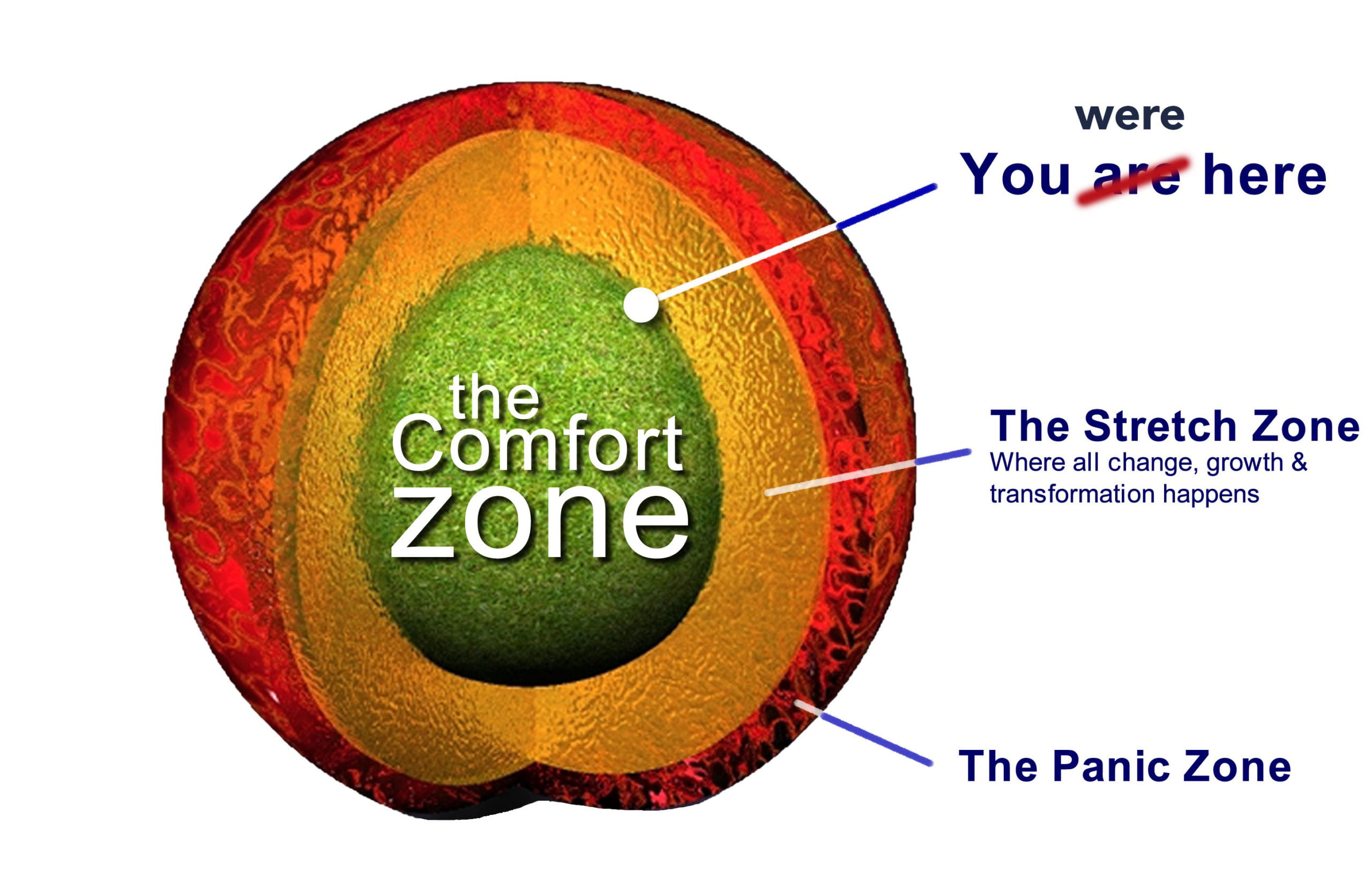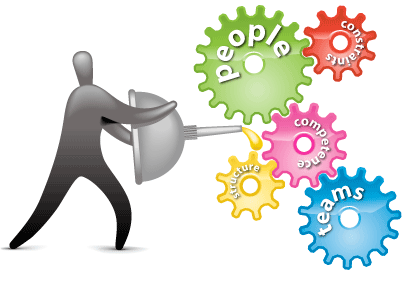
What kind of fear and vulnerability makes your teammates lose sleep at night?
The best way to find out is simple, but not always easy: ask them!
In this post, I present a technique — suitable for a retrospective or a lift-off — that opens up channels of communication about the topics of fear and vulnerability.
Sometimes all it takes to open the gates is for a single individual to step up ... Share on XSet the Stage
When I run this exercise, I begin with some conceptual groundwork.
I first draw a diagram of three concentric circles and explain that each one of us steps in and out of those zones as we interact as a team:
- The Comfort Zone – Ah, an easy and nice place to be. Nothing here worth losing sleep about, and little to no anxiety. (In The Path of Least Resistance Robert Fritz points out this zone might not actually be a comfort zone but instead a “Zone of Tolerable Conflict,” one designed to manage discomfort, not produce comfort )
- The Stretch Zone – AKA No Pain, No Gain. This is a place of risk, and it can be downright uncomfortable for many. However, this zone is where growth usually happens.
- The Panic Zone – The land of freeze, flee, or fight. It’s best to not go here since in this zone we tend to get dumber. Studies have shown that when we are in a stressed or threatened state (i.e., when the amygdala is on high alert), there is less oxygen and glucose for the neocortex’s cognitive functions.
I then explain that moving outside of one’s comfort zone and into the stretch zone where perceptions expand and transformations take place can be scary. Fear is often about risk; more specifically, the risk of losing something. Maybe we get defensive or aggressive when faced with that risk. Maybe our stomachs get queasy. We all have our own personal early warning systems.
I share a quote from Abraham Maslow: “In any given moment, we have two options: to step forward into growth or to step back into safety.”
Choose a similar mantra or quote that makes sense in your team’s context.
I then explain that to continuously improve as a team each one of us needs to get out of our comfort zone, and doing so requires at least two things: trust and honesty.
Trust at Multiple Levels
- Personal: You trust yourself to have the courage and bravery to persevere and recover from any failure
- Personal + Relational: Trust in yourself to recognize your panic zone and be heard by your teammates if you say, “too far!”
- Relational: Trust in your teammates, coach, and leader that they will pull, push or prod you along and support you when you need it
Honesty
- To admit your fears and your sense of vulnerability
- To bring your full, authentic self without pretense
- To shine a light on your flaws (as the great Zen master Shunryu Suzuki once said, “Everything is perfect and there is always room for improvement.”)
Four Windows into Fear
In any given moment, we have two options: to step forward into growth or to step back into safety. Share on XNext, I draw a quadrant on the whiteboard and discuss four viewpoints, from Integral Theory:
- I = Personal – This is about “Me” – my psychological, inner world; how I see things, what I experience, my mindset, and my level of engagement
- IT = Practices – Refers to the team structure, methods, metrics, processes, decision-making patterns, organizational, leadership and team practices; competencies, products, and technologies.
- WE = Relational – a shared vision and interpersonal dynamics among peers; how we interact, what we value together, our shared vision, the team micro-culture communities, and centers of practice/excellence.
- ITS = Environmental – Everything external to the team systems, including other value streams, handoffs, rules, corporate culture, and policies
I explain that during this exercise the team is going to explore the ideas of trust, honesty, fear, and vulnerability in each of those four contexts.
The Really Scary Part
As I hand out Post-it notes and pens (digital or IRL), I ask, “What are the things you fear? Where is trust at risk? Write them down…one per note.”
I then give the team 7-10 minutes to silently brainstorm. When that timebox has been hit or the energy in the room has diminished, I have the team post their notes on the whiteboard in one of the four quadrants (many fears turn out to overlap quadrants, so they end up on the boundaries).
During the process of posting, I encouraged folks to affinity group their notes.
We quickly review the board. I then make available dots (5±2 depending on the number of affinity groups) and have individuals indicate their top concerns via dot voting.
What emerges time and time again follows a similar pattern: almost no post-it group has a single dot, and all fears fall into one of the following bakers’ dozen:
- Fear of being held accountable where I’m not responsible or in real control
- Fear of failure
- Fear of being underappreciated, or someone else taking credit for my ideas
- Fear of loss of a job or other reprisals
- Fear of loss of respect, reputation, or credibility
- Fear of letting others on the team down
- Fear of stagnation or chances of promotion and lack of personal growth
- Fear of conflict, of disagreeing with others, worry about boundaries of what’s appropriate or professional
- Fear of separation, alienation, being an outsider, upsetting “The Boss,” being labeled “not a team player”
- Fear of being wrong, looking dumb, or not smart enough
- Fear of what others think of me, being labeled a jerk or arrogant
- Fear of embarrassment, humiliation, or ridicule
- Fear of loss of identity and individualism (i.e., resistance is futile)
What Can We Do About Our Fears?
Stay afraid but do it anyway. What's important is the action. You don't have to wait to be confident. Just do it and eventually the confidence will follow. Carrie Fisher Share on XI then facilitate group idea generation while emphasizing that nothing is off the table. What can the team do about their fears? Example actions that have come up with include:
- Take responsibility for yourself. Acknowledging that you are becoming defensive or fearful. Try telling the person you are with that you’re starting to notice your defensiveness and fear.
- Slow Down. Take space, stay quiet for at least a 10-count, take two deep breaths and check or change your posture.
- Confront your negative self-talk. See if you can switch from red-zone to green-zone self-talk. (Read more about attitudes and intentions.)
- Check your assumptions. Everyone must make many assumptions daily to get by. There is nothing wrong with making assumptions, and it would be impossible to live a normal life without making them. The biggest problem with assumptions is the rigidity with which we hold them.
- Explore your fear with conscious awareness, trying to understand the root causes, and ask yourself, “What am I trying to override?” Try to look in all directions.
- Start over. When you realize that you have become defensive or fearful, acknowledge that, take some action to reduce your defensiveness/fear and then start over. (Read more on uncovering your defensive patterns.)
Look to the Future
No retrospective is worth its time unless it results in a plan for some things to change. So, I ask each participant to come up with a self-action plan. I provide some thought starters that correspond to the four windows:
Personal (I)
- What I’m expected to do is…
- I want to learn more about…
- I should ask for help when…
Relational (We)
- One thing we can both stop/start doing is….
- We are both motivated by….
- What we don’t dare to do yet is…
Practices (It)
- What I expect from my team leadership is….
- The reason the team is at risk is….
- What the team needs most is….
Environment (Its)
- I’m proud of our team/business unit/company when…
- What our stakeholders can expect from us is….
- The reason our value stream can be blocked is…
To wrap up, I ask if anyone would like to share their plans with the group. (This is where a facilitator’s ability to withstand awkward silence comes in handy!)
I’ll share with you a facilitator secret. If I suspect a team I’m working with doesn’t yet have a solid foundation of trust, and as a result, the majority is hesitant to be vulnerable in front of everyone, I will have a “plant” (someone I’ve spoken with beforehand) volunteer to speak up first. Sometimes all it takes to open the gates is for a single individual to step up and do something that feels unsafe and uncomfortable.
Build Upon the Foundation
A few days after the exercise, I will share Brene Brown’s wonderful thoughts on vulnerability as “the birthplace of innovation, creativity, and change” via her TED Talks and YouTube videos. Brown’s ideas will reinforce many of the concepts that likely bubbled up during the retrospective.
Another great TED Talk is by Tim Ferris: Why You Should Define Your Fears Instead of Your Goals
If we understand fear as an evolved survival mechanism, we gain some perspective and perhaps some release from our identification with the feeling. We might even arrive at a place where we can bow down to fear, seeing it as a friend who is looking out for our very life.
—Wes Nisker, “It’s Only Natural”
Myths of Vulnerability
In her book Dare to Lead (link below), Brown provides a list of six misguided myths that persist across wide variables including gender, age, race, country, ability, and culture:
- Myth #1: Vulnerability is weakness.
- Myth #2: I don’t do vulnerability.
- Myth #3: I can go it alone.
- Myth #4: You can engineer the uncertainty and discomfort out of vulnerability.
- Myth #5: Trust comes before vulnerability.
- Myth #6: Vulnerability is disclosure.
Perhaps these become seeds for more team-level conversation?
On any team, vulnerability-based trust is not a given, nor does it magically appear after a single retrospective. It will take time and many instances of individuals admitting their fears, their mistakes, and taking risks that move them outside of their comfort zones.
I’ll share with you a few more techniques that I’ve found helpful in accelerating the development of deep levels of trust in a team:
Take any or all of these exercises for a spin with your team, and feel free to share your experiences in the comments. What besides fear could be holding you back?
 Did this article help you out? Show your appreciation by buying me a virtual coffee. Help fuel more great content!
Did this article help you out? Show your appreciation by buying me a virtual coffee. Help fuel more great content! 



Pingback: Virtues for the Change Journey: Episode 1: Courage – The Path Begins – AgileUprising